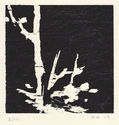
19th, 20th & 21st Century Fine Prints
707-546-7352 · fax 707-546-7924 · web: www.annexgalleries.com · email: artannex@aol.com
Sandy Walker Biography
Sandy Walker
American
1942
Biography
Sandy Walker, painter, printmaker, and art therapist, was born on 30 August 1942, in Washington, D.C. to Allan E. Walker, Jr. and Katherine Braxton Hall. Walker grew up in the capital and attended St. Albans School, where his passion for painting was encouraged by Dean Stambaugh. After graduating in 1960, Walker studied art history at Harvard and decided to pursue a career as an artist. After Harvard, he studied for one year at the Boston University School of Fine Arts followed by a year at the New York Studio School, where he worked with legendary teacher Mercedes Matter. In 1968, he received a M.F.A. in painting from Columbia University as a Brevoort Fellow.
In the fall of 1968, Walker established his studio in Brooklyn but moved constantly, living in Wyoming, California, and, finally, Washington, DC. In 1972, he returned to D.C. for four years, where he worked as an art therapist at the Psychiatric Institute and later taught at Northern Virginia Community College.
In the summer of 1975, while staying in a cabin in Nova Scotia, Walker underwent a transformation of observation and method of working. His pattern of working consisted of traveling to a landscape site, creating a series of drawings followed by small paintings from which he would paint a summarizing large scale work. In 1976, he painted at the Grand Canyon, Mount Shasta, and Niagara Falls, creating one large diptych at each site.
Walker’s first important exhibition was at the Grace Borgenicht Gallery in New York in 1977. Subsequent solo exhibitions at the gallery followed in 1978 and 1980. During these years Walker traveled extensively, including painting trips to the Outer Banks of North Carolina, the Grand Tetons in Wyoming, and New Hampshire. Walker was selected for two residencies in 1980, the MacDowell Colony and Cite Internationale des Arts in Paris. Walker returned to painting but focused on the essence of the landscape, resulting in a pictorial vocabulary more abstract and symbolic.
Walker met dancer and choreographer Ellen Webb in 1977 and they began collaborating on projects that combined their interests. They married in Paris in 1981 and made annual summer sojourns to Stehekin, Washington in the North Cascades National Park, which became both subject and inspiration for Walker's landscapes. They settled permanently in Oakland, California in 1984.
During the 1980s, Walker began making woodblock prints. Working with master printer John Stemmer, and later with Joan Hall and Romi Sloboda, he made over thirty mostly hand-printed editions. In 1995, the Cleveland Print Club selected Walker as the artist for their 75th Anniversary print edition. That same year the List Art Center at M.I.T. organized a two year travelling exhibition of his woodblock prints. Collaborating in the mid-1990s with master silk screen printer Sheila Marbain in New York, Walker began experimenting with color prints. A long-time member of the California Society of Printmakers, in 1999 he served as guest editor of The California Printmaker.
Concurrently with painting and travel, Walker and his wife maintained a close collaboration on dance performances. He was recognized for this work in 1989 when he won a prestigious Isadora Duncan Dance Award for Visual Design. That same year, Walker’s first museum exhibition was mounted at the Riverside Art Museum. Shows at the Nicolaysen Art Museum, the San Jose Museum of Art, the Fresno Art Museum, the Ulrich Museum of Art, and the Triton Museum followed throughout the next two decades.
Sandy Walker is represented in the collections of the Berkeley Art Museum and Pacific Film Archive, California; the Bowdoin College Art Museum, Brunswick, Maine; the Ackland Art Museum, University of North Carolina at Chapel Hill; the Cleveland Museum of Art, Ohio; the Museum of Modern Art and the Whitney Museum of America Art, New York; the Fine Arts Museums of San Francisco, California; and the Smithsonian American Art Museum, Washington, D.C.






